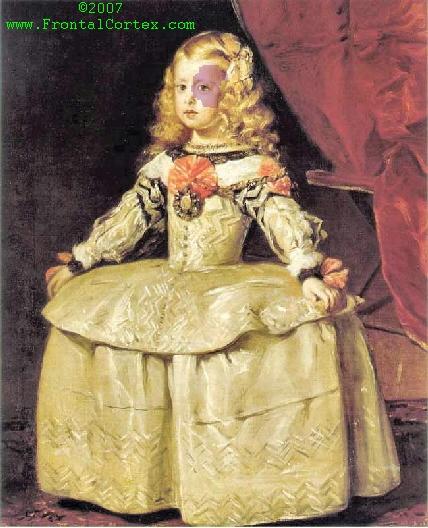Neurocutaneous Syndromes 07
Topic: Pediatric
Created on Wednesday, January 28 2009 by jdmiles
Last modified on Sunday, February 15 2009.
The parents of the Infant Marguerite Therese (shown in the image above) have brought her to your clinic because she suffers from frequent seizures, which affect only the right side of her body. They are wondering if Marguerite Therese is likely to eventually pass this disorder on to her children. You explain to them that the inheritance pattern of this disorder is...
This question was created on January 28, 2009 by jdmiles.
This question was last modified on February 15, 2009.
ANSWERS AND EXPLANATIONS
A) X-linked recessive
This answer is incorrect.
Little Marguerite Therese has Sturge-Weber syndrome (SWS), is a sporadic neurocutaneous disorder which consists of a port-wine stain in the V1 region of the face, and a venous angioma in the pia mater. 80% of children with SWS have seizures. (
See References)
|
 |  |  | 
|  |  |
| Please log in if you want to rate questions. |
B) Autosomal dominant
This answer is incorrect.
Little Marguerite Therese has Sturge-Weber syndrome (SWS), is a sporadic neurocutaneous disorder which consists of a port-wine stain in the V1 region of the face, and a venous angioma in the pia mater. 80% of children with SWS have seizures. (
See References)
|
 |  |  | 
|  |  |
| Please log in if you want to rate questions. |
C) Sporadic
This answer is correct.
Sturge-Weber syndrome (SWS) is a sporadic neurocutaneous disorder which consists of a port-wine stain in the V1 region of the face, and a venous angioma in the pia mater. The angioma is usually ipsilateral to the port-wine nevus, but may be bilateral. Only 10%-20% of children with a port-wine nevus have a venous angioma.
80% of children with SWS have seizures. 80% of children who have SWS and develop seizures in the first year of life will have developmental delay.
(
See References)
|
 |  |  | 
|  |  |
| Please log in if you want to rate questions. |
D) consistent with a trinucleotide repeat
This answer is incorrect.
Little Marguerite Therese has Sturge-Weber syndrome (SWS), is a sporadic neurocutaneous disorder which consists of a port-wine stain in the V1 region of the face, and a venous angioma in the pia mater. 80% of children with SWS have seizures. (
See References)
|
 |  |  | 
|  |  |
| Please log in if you want to rate questions. |
E) Autosomal recessive
This answer is incorrect.
Little Marguerite Therese has Sturge-Weber syndrome (SWS), is a sporadic neurocutaneous disorder which consists of a port-wine stain in the V1 region of the face, and a venous angioma in the pia mater. 80% of children with SWS have seizures. (
See References)
|
 |  |  | 
|  |  |
| Please log in if you want to rate questions. |
References:
| 1. Victor, M., and Ropper, A.H. (2005). Adams and Victor's Principles of Neurology, 8th Edition. McGraw-Hill, New York. (ISBN:007141620X)
| Advertising:
|
| 2. Di Rocco, C., and Tamburrini, G. (2006). "Sturge-Weber syndrome." Childs Nerv Syst, 22(8) 909-21. (PMID:16823586)
|  |
| 3. Rowland, L.P. (Ed) (2000). Merritt's Neurology, 10th Edition. Lippincott Williams & Wilkins, Philadelphia. (ISBN:0683304747)
| Advertising:
|
| 4. Santos, C.C., Miller, V.S., and Roach, E.S. (2004). Neurocutaneous syndromes. In Bradley, W.G., Daroff, R.B., Fenichel, G.M., and Jankovic, J. (Eds.). Neurology in Clinical Practice, Fourth Edition. Butterworth Heinemann, Philadelphia, pp. 1867-1900 (ISBN:0750674695).
| Advertising:
|
|
 |  |  | 
|  |  |
| Please log in if you want to rate questions. |
FrontalCortex.com -- Neurology Review Questions -- Neurology Boards -- Board Review -- Residency Inservice Training Exam -- RITE Exam Review
pediatric
Neurocutaneous Syndromes 07
Question ID: 012809037
Question written by J. Douglas Miles, (C) 2006-2009, all rights reserved.
Created: 01/28/2009
Modified: 02/15/2009
Estimated Permutations: 600

























